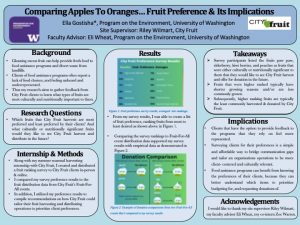Comparing Apples to Oranges… Fruit Preference & It’s Implications
Users of food assistance programs often feel unheard and underrepresented by the program that supports them. This is why it is vital that food assistance programs and organizations should consider gathering direct feedback from their users, to foster better relationships, and prioritize requested food that is more culturally and nutritionally relevant. The aim of this study was to gather the fruit preferences of City Fruit recipients, as well as gather recommendations for culturally significant fruits. I gathered data utilizing a survey which was distributed during weekly fruit giveaway events in Seattle. Furthermore, I compared my survey results to fruit giveaway event data containing information regarding how much fruit was brought to the event vs. how much was left after the event, to see if the survey preference results were supported. My project was able to compile rankings for each of the 12 fruits I included in the survey, ranked from most to least preferred. And based on my comparison, the survey rankings aligned with rates of distribution seen at the giveaway events. Furthermore, based on the results of my survey, I was able to provide recommendations for City Fruit regarding operations. Firstly, these results are important because they provide an outlet of direct feedback from fruit recipients to City Fruit, bridging a potential communication gap. Secondly, the results could be a starting point for City Fruit to tailor their harvesting request selection and subsequent harvesting routes and donations, to prioritize fruits that are most preferred.
